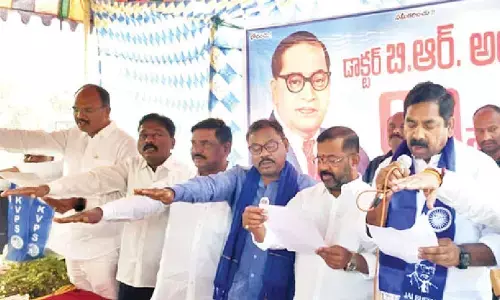Tracking divestment over decades

Tracking divestment over decades
The present BJP government of Narendra Modi has come up with an industrial policy of disinvestment where in all non-strategic sectors government will fully withdraw and in strategic sectors that have been identified government will have a presence of minimum of one and a maximum of four. The present disinvestment proposal of Vizag Steel is part of this broad policy framework of Government of India.
The present BJP government of Narendra Modi has come up with an industrial policy of disinvestment where in all non-strategic sectors government will fully withdraw and in strategic sectors that have been identified government will have a presence of minimum of one and a maximum of four. The present disinvestment proposal of Vizag Steel is part of this broad policy framework of Government of India. If somebody wants to question this decision it should be based upon the issues of viability of the steel project to sustain in the long run as a public sector undertaking rather than to bring in issues of sentiment self-respect etc. which may not have a role in decision making . Decision needs to be purely based on sustainability of the venture in a competitive environment
Those of us who were students in the 1960s remember two agitations that happened in quick succession - the anti-Hindi agitation of 1965 and the Vizag Steel plant agitation of 1966. Vizag Steel agitation which caught up as a wildfire and paralysed life in Andhra Pradesh for a while also subsided quickly once the then chief minister of Andhra Pradesh Kasu Brahmananda Reddy gave lemon juice to the then fasting activist Amrita Rao Garu whose fast unto death sparked the agitation .
By 1965, the Government of India recognised Vizag as the right place for locating shore-based steel factory but the delay in its implementation led to this agitation. May be due to the agitation or most probably in its own routine Vizag Steel plant was announced by the then Prime Minister of India Mrs Indira Gandhi in 1970. The actual process of setting up started in early 1980s and the plant was dedicated to the nation in 1991 by the then PM, P V Narasimha Rao. Vizag Steel plant also can be a case study to see how public sector companies get delayed inordinately making them economically unviable. Announced in 1970s actual work starts in 1980s, finally becomes operational only in 1990s.
Vizag Steel plant as well as other steel plants which were established in the public sector earlier are part of the commanding heights principle enunciated by Jawaharlal Nehru as part of the 1956 industrial policy. As per this policy all heavy capital-intensive companies were reserved to be set up in the public sector and the private sector is barred from setting them up. Thus came in public sector steel factories, BHEL, HMT and a number of such companies. Private sector was limited to production of consumer goods. The public sector further expanded to cover some non-strategic sectors which are not capital intensive like the hotels , bread factory etc. in due course.
By early 1990s it became clear these public sector enterprises described as temples of modern India have in fact turned out to be a big drag on the resources of the country. Most of them working under monopoly conditions were not subject to competition and a lot of inefficiency and corruption got built up in these institutions. Managerial accountability was not there, and lack of clear-cut objectives and sometimes contradictory objectives led to a situation where most of them instead of declaring a net return to the government started becoming a drag on the resources of the economy. They started getting budgetary support year on year just to survive on ventilation.
By 1990s with Indian economy in deep turmoil, disinvestment in public sector enterprises became an important part of the economic reforms that were taken up by PV Narsimha Rao government .This was a process continued by different governments in power in the last 30 years irrespective of the party affiliation.
The present BJP government of Narendra Modi has come up with an industrial policy of disinvestment where in in all non-strategic sectors government will fully withdraw and in strategic sectors that have been identified government will have a presence of minimum of one and a maximum of four.
The present disinvestment proposal of Vizag Steel is part of this broad policy framework of Government of India. If somebody wants to question this decision it should be based upon the issues of viability of the steel project to sustain in the long run as a public sector undertaking rather than to bring in issues of sentiment self-respect etc. which may not have a role in decision making . Decision needs to be purely based on sustainability of the venture in a competitive environment.
People who question the privatisation of the steel plant should also bear in mind what is happening around the world. Number of Steel plants that were in public sector in the erstwhile Soviet Union and East European communist countries have become sick and were taken over by entrepreneur of Indian origin Lakshmi Mittal who made them profitable. Similarly, a sick British Steel company Corus was acquired by Tata Steels. When trade is becoming international companies are becoming international and competition international, it may not be correct to harp on sentiment or self-respect and try to make out a case for continuing the steel plant in the public sector.
The only way a case can be made out for continuing a steel plant in public sector is to show that it can be profitable in the long run even as a public sector undertaking, provided it is allowed level playing field compared to other steel factories in the public sector. Two important factors that seem to be working against the Vizag Steel plant compared to other Steel plants in the public sector are lack of captive mines and the high cost debt. When there was a possibility for getting captive mines allocated management did not seem to have pursued the case as required.
Today the whole policy of allotment of mineral wealth is changed and it is based on a competitive bidding process. How far and to what extent an exception can be made to Vizag Steel in this regard and its broader legal implications will decide a decision on this. An alternative could be to merge Vizag Steels with SAIL. Even while considering that alternative focus should be more on the sustainability and long-term viability of the company.
However, there is one aspect that the government needs to keep in mind while going in for disinvestment in public sector undertakings. What if a crony capitalist mobilises the required funds from public sector banks to bid for a PSU company and make those loans NPAs a decade later. That would be the worst possible solution for the whole exercise of disinvestment. Given our legacy problems it would be appropriate if RBI and ministry of Finance specifically prohibit PSU banks financing of these disinvestment proposals.
The days of throwing good money after bad money just to sustain a public sector undertaking have gone. They can only survive if they are competitive in an unprotected environment. Sooner this is realised, it is better for all.
(The author is a former Chief Secretary, Govt of Andhra Pradesh)



















